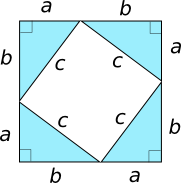
Pythagoras of Samos
[ccbysa3]
It may very well be the second most famous equation of all time, outshone only by that braggart Einstein’s mass–energy equivalence equation. But for those of us that aren’t theoretical physicists, the Pythagorean Theorem is likely to play a fundamental role in many of the calculations we do whether we realize it or not.
Everyone knows the equation, but before we get into it’s proof, let’s re-cap what it means. Consider the following right triangle:

This triangle has sides ![]() and hypotenuse
and hypotenuse ![]() . The Pythagorean Theorem simply tells us then that the square of the length of the hypotenuse (
. The Pythagorean Theorem simply tells us then that the square of the length of the hypotenuse (![]() ) is equal to the square of the length of side
) is equal to the square of the length of side ![]() plus the square of the length of side
plus the square of the length of side ![]() (
(![]() ). Well, duh. And after we learn it in middle school many of us take it as axiomatic, but it does have “theorem” in it’s name so I feel its worth revisiting it’s proof every once in a while to keep me on my toes.
). Well, duh. And after we learn it in middle school many of us take it as axiomatic, but it does have “theorem” in it’s name so I feel its worth revisiting it’s proof every once in a while to keep me on my toes.
Proof
It turns out that there are many ways to prove the Pythagorean Theorem. What follows is one of the simplest and easiest to aid in visualizing how the theorem was derived.
Let’s start with the same triangle as above:

and make four copies of it, arranging and aligning them vertex to vertex to create the shape below:

Now we have a square with sides of length ![]() . This square has a second square (in white) circumscribed within it that has sides of length
. This square has a second square (in white) circumscribed within it that has sides of length ![]() .
.
Let’s start thinking about areas. For a single, blue triangle, we know that the area (I’ll call it ![]() ) is:
) is:
(1) ![]()
The area of the outer, all-encompassing square, henceforth known as ![]() , is:
, is:
(2) ![]()
The inner, white square formed by the hypotenuses (Yes, I couldn’t believe it either. The plural of hypotenuse is hypotenuses. How is it that I am 43 years old and never had to use the plural of hypotenuse in a sentence? I am almost sorry I Googled it, because I would rather have used hyponteni in ignorance.) Shit, where was I? That’s right, the white square’s area which I have christened ![]() is:
is:
(3) ![]()
Wait a minute! ![]() is one of the terms in our Pythagorean Theorem. Looking at the diagram we can see that the area of the inner square is equal to the area of the outer square minus the areas of our four blue triangles.
is one of the terms in our Pythagorean Theorem. Looking at the diagram we can see that the area of the inner square is equal to the area of the outer square minus the areas of our four blue triangles.
(4) ![]()
Let’s substitute our areas into the above equation, simplify and see where that gets us.
![]()
![]()
![]()
Hot damn! We’re done. And that is why this is my favorite Pythagorean Theorem proof. Maybe someday when I am bored I’ll throw up one or more of the red headed stepchildren proofs. If I were you I wouldn’t hold my breath.
